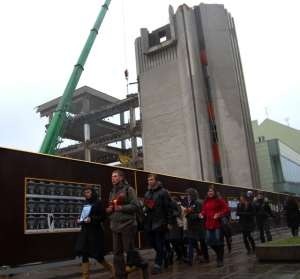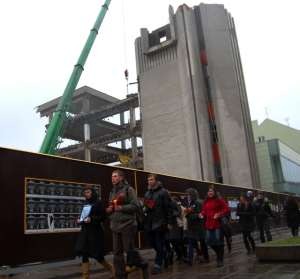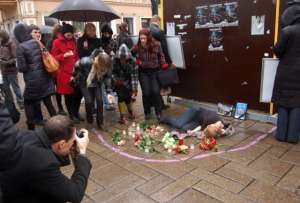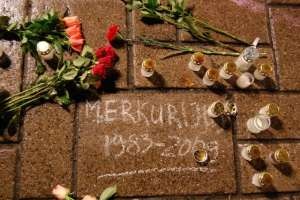MERKURIJUS SHOPPING CENTRE IN KAUNAS: 1983 – 2009 0
Simona Rybakovaitė
www.kamane.lt , 2009 11 22
Photos by M.Dabašinskas
In brief: A performance “Burial of Merkurijus” was organised in Kaunas Laisvės Alley. The artist Justina Balčiūnaitė and Master students of Vytautas Magnus University, Faculty of Arts, L.Baublienė, I.Taparauskaitė, E.Každailytė, E.Mozūraitytė joined their creative and organisational skills in order to honour the commercial giant that has turned into debris and to memorialise the Soviet shopping centre Merkurijus.
When larger shopping centres appeared after regain of Lithuania’s independence, Merkurijus lost its importance; however, it was kind of a symbol of Laisvės Alley and caused nostalgia for many elder passers-by. Young people, especially students, used to gather in the yard of the shopping centre in the warm season to chat and to have a snack.
There has appeared a group of enthusiasts who decided to show that they were concerned about the farewell to Merkurijus. It could be explained by sentiments or by the feeling of injustice regarding the works of the architect Algimantas Sprindys (ill success pursues the architect – his works are pulled down one after another). Or perhaps it was a wish to gather and present material about the commercial giant of the Soviet times to people, while the frame of the building is still in place and every passer-by remembers how the former building looked like.
The performance started by several figures lined at the fence of constructions around Merkurijus. Young women held framed photographs from the period when the department store was open. The photographs reflected the change of interiors of the shopping centre, the relation of the facade and the surroundings in different decades. It was possible to see how the building looked like from various sides.
The life of Merkurijus was also pictured by a dancer standing among figures holding photographs. One could understand that the woman embodied the life of the store. The dancer stood in the zone of the pavement surrounded by a white line and marked by a tombstone-like inscription: Merkurijus 1983 – 2009. Merkurijus moved, danced, pronounced a poetical phrase and died. The pose of a lying body on the cold pavement symbolises the grave. At the same time it is the allegory of the unneeded, forgotten and thrown-away thing. In this situation the dead building turned into a person, who was born at some time, lived and died.
Spectators and mourners gathered to say farewell to Merkurijus at its grave. The participants of the performance, the crowd of mourners marched with sad faces from St. Archangel Michael Church. The portrait of the shopping centre with a black ribbon was carried in front of the walking people. After honouring the grave of Merkurijus with flowers and candles, the mourners said a speech dedicated to the largest Kaunas shopping centre of the Soviet times. It was ironic and bombastic at the same time.
The performance ended with a phrase “this is the end”. The participants drifted away. Some of them did not explain anything to anybody and took their own direction, while others still lingered on. The end was flash mob-like by its silence and abruptness.
The humour and irony of the performance are suitable methods to speak about the relations of an artwork, artist, society and authorities. Neither the artist nor students are capable of changing anything. Still, they may express their position aloud. It is already a signal that there are some concerned people in the indifferent society.












